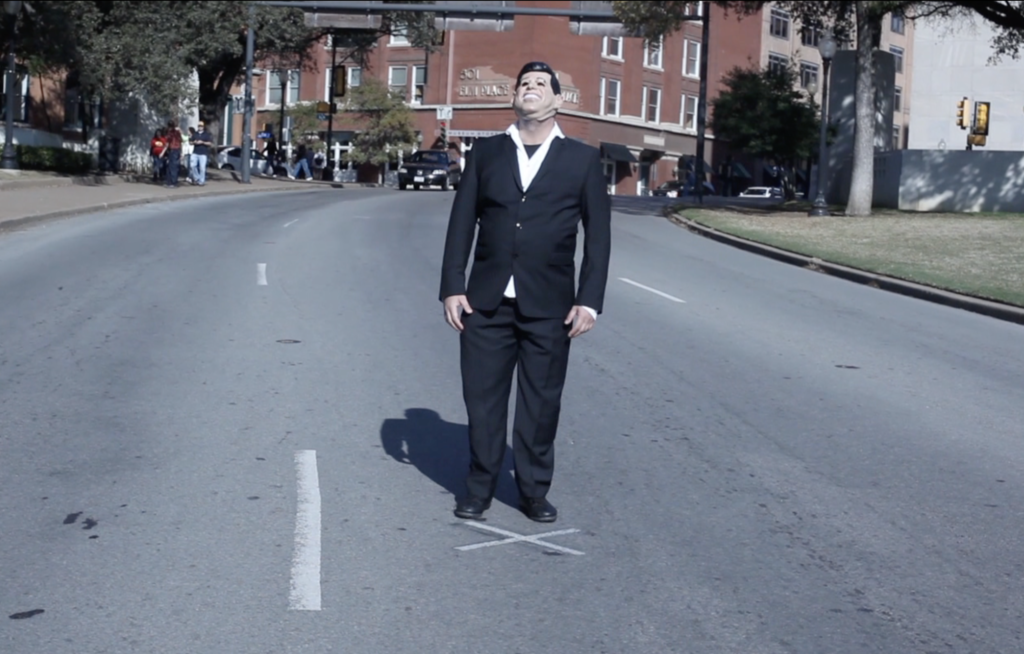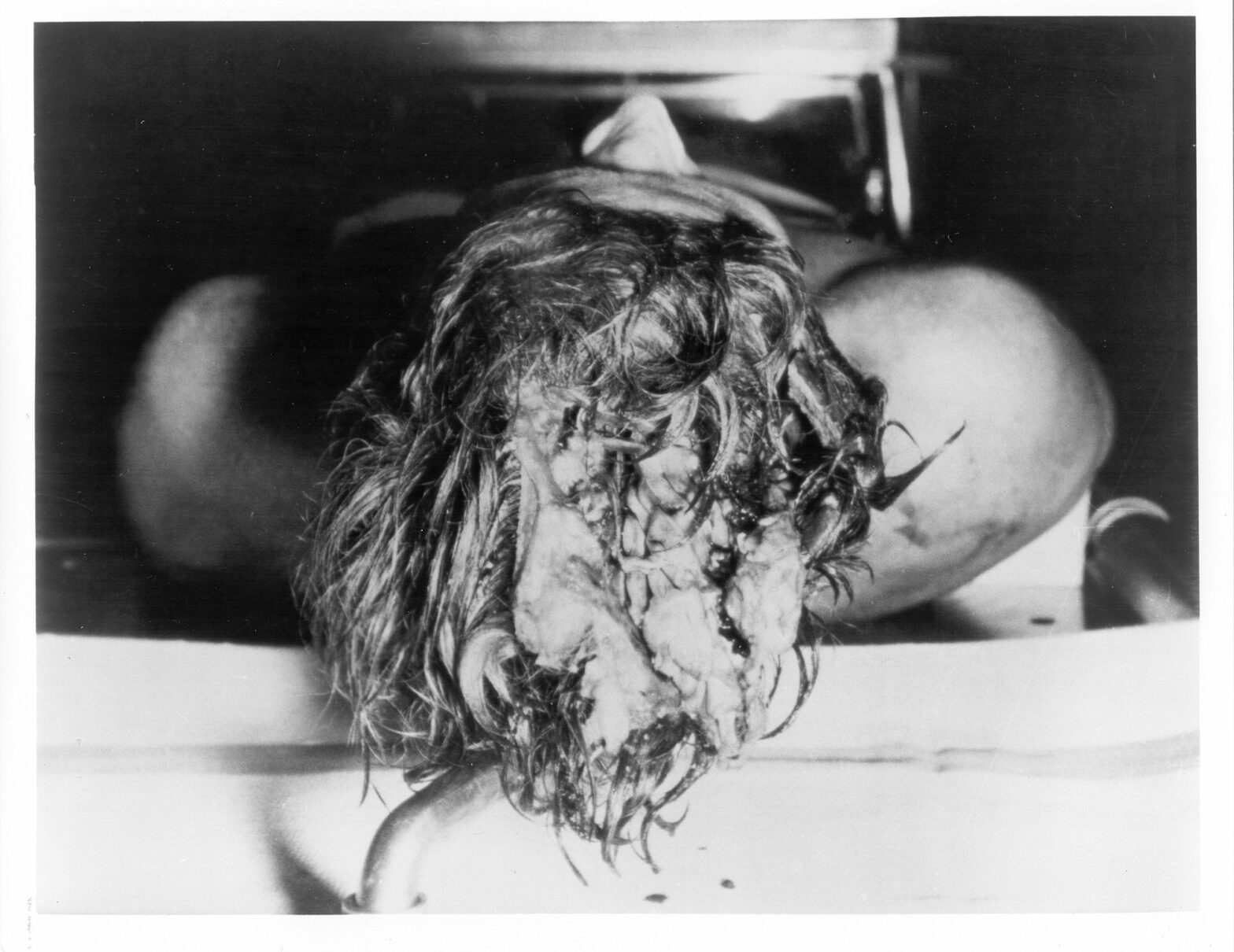Investigating the murder of John F. Kennedy
In der finalen dreiteiligen Version von The Big Event beleuchtet toxic dreams (Künstlerische Leitung: Yosi Wanunu & Peter Stamer) die dunklen Ecken des Tatorts, untersucht akribisch den genauen Zeitablauf der Tat, verfolgt die Spuren von Zeugen und vermeintlich Tatbeteiligter bis zu ihrem Ende: toxic dreams begibt sich auf die Suche nach der ultimativen Wahrheit …
President Kennedy’s assassination is the work of a magician. A stage trick, complete with accessories and fake mirrors, and when the curtain falls, the actors, and even the scenery, disappear in the shadows of darkness. When the curtain goes up again after the show, technicians rush on stage to take down the set. They look into the magicians’ boxes, eager to find secret compartments, trap-doors or at least invisible strings somewhere. But there are no such things. The mad man’s trick: to blind a squinting world with bright day-light.
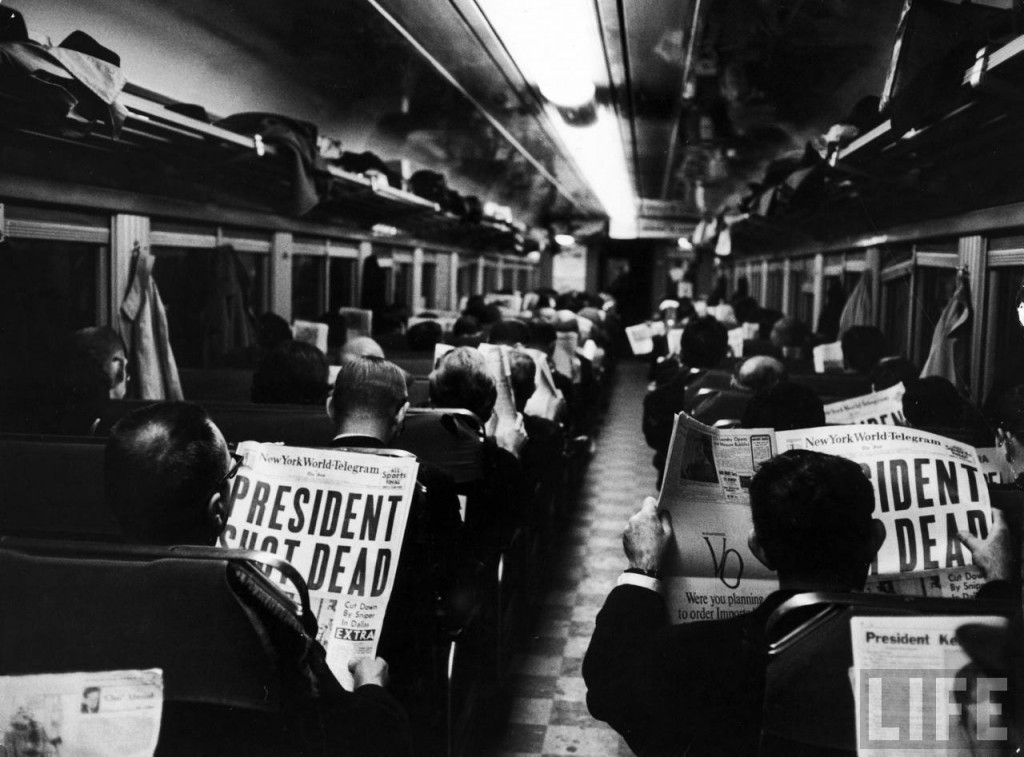
Das Attentat auf den 35. amerikanischen Präsidenten John F. Kennedy am 22. November 1963 hatte weltweit enorme gesellschaftliche und politische Konsequenzen, die bis heute nachwirken. Im März 2012 nahmen im Auftrag von toxic dreams zwölf Mitglieder einer international besetzten Untersuchungskommission im WUK ihre Beschäftigung mit den Hinter- und Abgründen des geheimnisvollsten politischen Kriminalfalls der jüngeren Zeitgeschichte auf. Unmittelbar und noch Jahrzehnte nach dem Anschlag haben der Secret Service, FBI, CIA und diverse Kommissionen mehr als 25.000 Zeugen vernommen. Von mehr als hundert Zeugen wird behauptet, sie seien auf mysteriöse Weise umgekommen oder verschwunden. Eine nie dagewesene Flut an Büchern, Filmen, Dokumenten, Fotos, Fakten, Geschichten wurden in der Folge publiziert, über kein anderes Eintagesereignis wurde je so viel spekuliert: Verschwörungstheorien schießen bis zum heutigen Tag ins Kraut und verunsichern mit ihrer Frage „Who really dunnit“ nicht nur die amerikanische Öffentlichkeit und ihr Vertrauen in die Politik. Ob tatsächlich politische Geheimbünde, Liebhaberinnen im Spionageauftrag, Mafiabosse und Untermänner ihre Finger im Spiel hatten, ob außenpolitische Geheimdienstaktiviäten oder handfeste wirtschaftliche Interessen ausschlaggebend waren, der Fall ‚JFK’ stellt eine wilde Mischung aus Fakten und Fiktion dar. Zum Tatzeitpunkt, am 22. November 1963 um 12.35 Uhr, befanden sich Hunderte Medienvertreter bereits ein paar Meilen entfernt im Dallas Trade Mart, wo nach der als unspektakulär eingeschätzten Fahrt durch die Innenstadt eine Rede des Präsidenten im Rahmen eines Mittagessens geplant war. JFK kam nie an, die Dokumentaristen der neuen Zeit – das Fernsehen und ihre Vertreter – befanden sich zur falschen Zeit am falschen Ort.
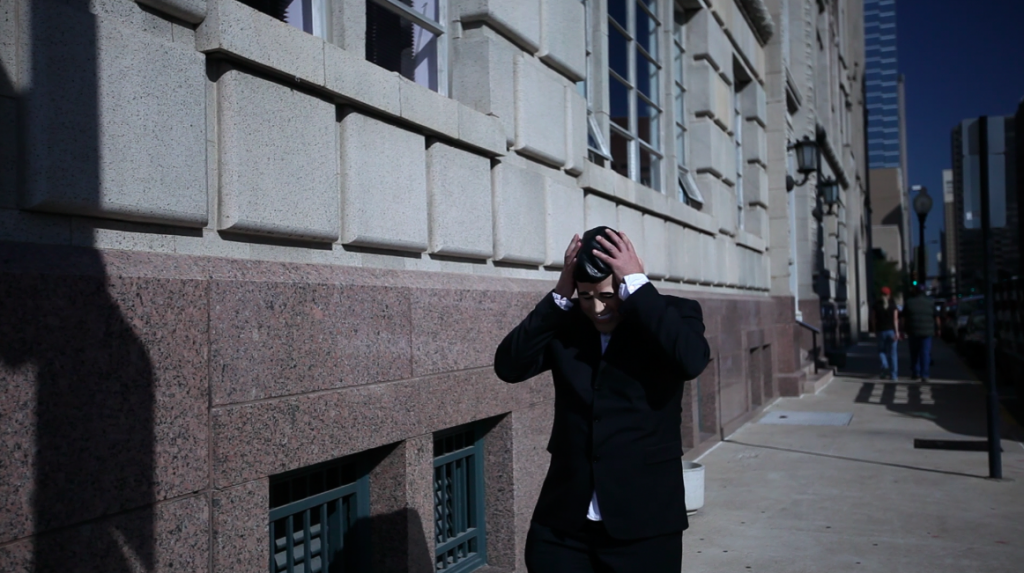
In der finalen dreiteiligen Version von The Big Event beleuchtete toxic dreams (Künstlerische Leitung: Yosi Wanunu & Peter Stamer) die dunklen Ecken des Tatorts, untersuchte akribisch den genauen Zeitablauf der Tat, verfolgte die Spuren von Zeugen und vermeintlich Tatbeteiligter bis zu ihrem Ende: toxic dreams begab sich auf die Suche nach der ultimativen Wahrheit – und benötigte dazu die Hilfe des Publikums.
Teil 1 analysierte in geraffter und überarbeiteter Version und mit teilweise neuem Material die Aufklärungsarbeit der Kommission.
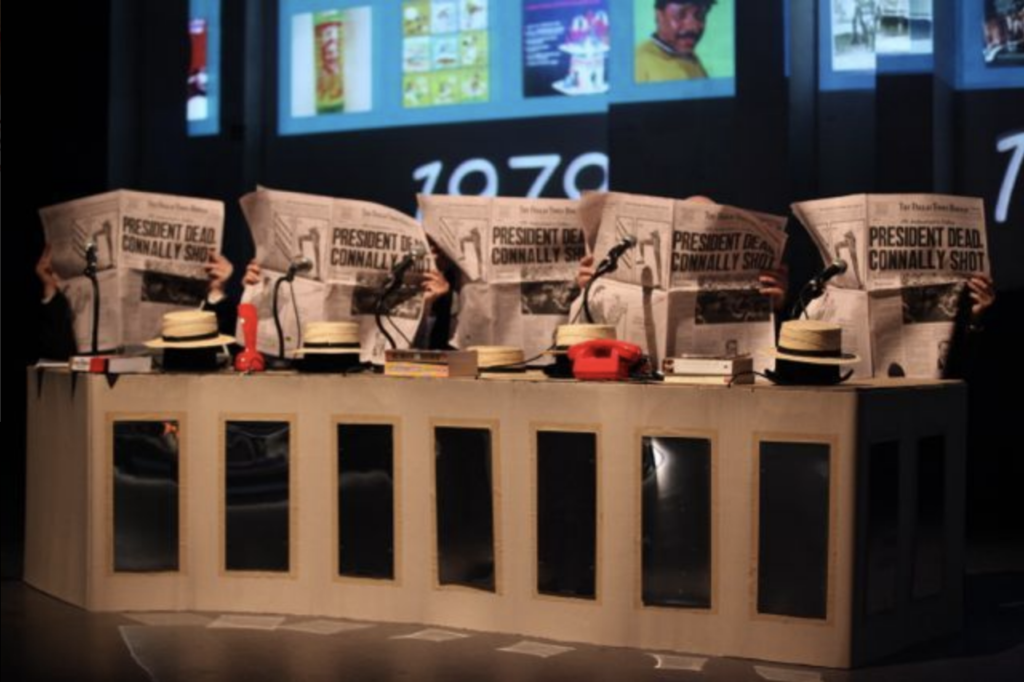
In Teil 2 holte das Team das nie stattgefundene Luncheon nach. Nach dem Essen wurde in Teil 3 der Tathergang bei einem Ortstermin genauestens rekonstruiert, das historische Ereignis im authentischen Re-Enactment, über unseren Köpfen eine Dokumentation unserer Reise nach Dallas.
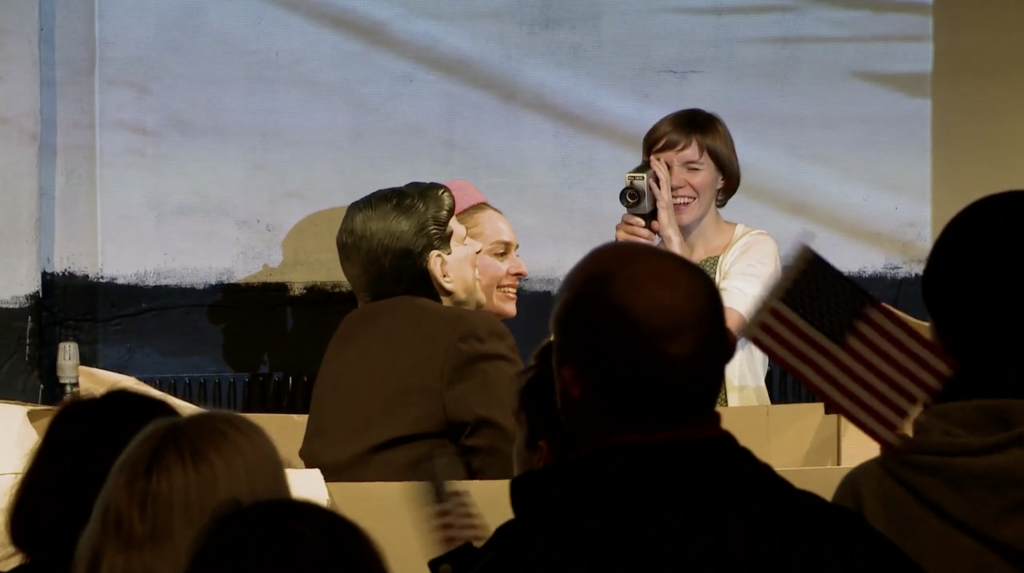
PerformerInnen: Irene Coticchio, Anna Mendelssohn, Tony Torn, Magda Loitzenbauer, Agnieszka Dmochowska, Charlotta Ruth, Stephanie Cummings, Cezary Tomaszewski, Jonas Ferdinand Kilga, Peter Stamer, Michael Strohmann, Yosi Wanunu, Mayasari Feradina Zoesmar und Gäste
Recherche: Peter Stamer, Yosi Wanunu, Michael Strohmann, Kornelia Kilga
Video: Michael Strohmann
Bühne: Mayasari Feradina Zoesmar, Yosi Wanunu
Künstlerische Gesamtleitung: Yosi Wanunu und Peter Stamer
Produktion: Kornelia Kilga
Fr 7. – Sa 15.12. 2012, 20 Uhr. In Koproduktion mit WUK Wien
Find out more about the project in English here
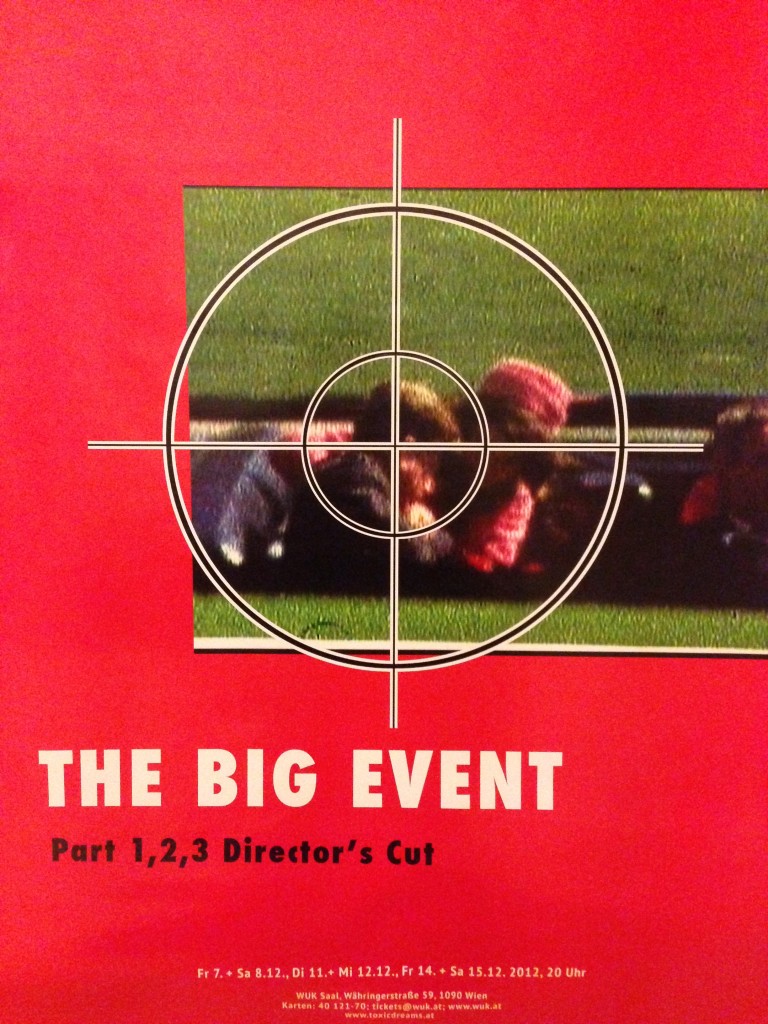
DerStandard vom 12. Dezember 2012
“The Big Event”: Fähnchen schwenken für Jack und Jackie
In einem vierstündigen Abend im Wuk nimmt sich die Performance-Truppe Toxic Dreams des Mords an John F. Kennedy an
Die Ermordung John F. Kennedys 1963 in Dallas ist ein Mythos der modernen Mediengesellschaft. Kaum einer war damals dabei, aber alle kennen die Bilder und Theorien. In einem vierstündigen Abend im Wuk nimmt sich die Performance-Truppe Toxic Dreams nun des Mordfalls an: “The Big Event – Director’s Cut”. Im ersten Teil wird das Publikum ordentlich auf Sixties und die zahlreichen Verschwörungstheorien gebrieft.
An 1960er-Jahre-Comedian Lenny Bruce angelehnt, präsentiert Yosi Wanunu als Showmaster Wahlwerbung und Reden, den Modetanz Twist, aber auch “Verhöre” mit Gespielinnen des Präsidenten oder Fidel Castro. Letzterer wird von einem Schulkind mit Zigarre verkörpert, auch andere Einfälle sind charmant und detailverliebt – so tragen alle Performerinnen das rosa Kostüm, in dem Jackie Kennedy in Dallas Witwe wurde. Teil zwei macht die Zuschauer zu Statisten: Bei einem (sehr feinen) Drei-Gänge-Menü mimen sie jene Medienvertreter, die einst vergebens auf den Präsidenten warteten.
Ein Film zeigt währenddessen, wie Toxic Dreams in Dallas auf Verschwörungstheoretiker und Zeitzeugen trafen. Teil drei schließlich lässt die Air Force One auf einer Leinwand im Saal landen, das Publikum wird angehalten, Jack und Jackie mit USA-Fähnchen zuzujubeln. Anschließend fahren die beiden wieder und wieder in einer Kartonlimousine ein paar Meter ihres einstigen Weges. Einige der damaligen Amateurfilmer werden mit Scheinwerferlicht aus dem Geschehen herausgehoben und vorgestellt. Nahm der informationslastige erste Teil das Publikum nicht immer mit (Ausnahmen waren pointierte Spielszenen wie etwa die Lincoln-Ermordung), ist der letzte Teil treffsicherer. Atmosphärisch dicht lässt er die Begeisterung, Hoffnung und Verunsicherung hinter dem Mythos nachfühlen.
Some notes from the field trip to Dallas in November 2011
Weather conditions history. It’s a coincidence that made history. If the weather had been worse, the United States of America wouldn’t have to undergo one of the biggest tragedies in their history. If it had rained on Nov 22, 1963, Kennedy would have been forced to use a bubble top on his Lincoln convertible to be protected from raindrops. For sure, Jacqueline wouldn’t have liked it to get her famous pink dress wet on that day. Well, as her day really ended she had lost her husband, America had lost their 35th president, and the pink dress had some bloody stains on it. Unfortunately, the Texan weather is too good in November. It seems to be always good, never let’s you down, also not on November 19, 2011 as we walk out the Hyatt Regency. A huge building next to Reunion Tower the name of which dates back to some French settlers in the 18th century who wanted to lead a simple life once they reached American shores. A story we heard from our cab driver who had brought us here the night before, after a tedious 18 hour trip from Vienna/Berlin. The talkative man gave us some insight into how he sees the world: the occupy movement doesn’t really know what they want; the real estate bubble was a mistake; the mafia was somehow involved in the Kennedy assassination. This is the reason why we came to Dallas: we want to understand how this city functioned back then, see with our own eyes what we have read in books, watched in documentaries about this day of 22 November 1963. Have a nice stay! says a woman with a broad smile when we arrive at the hotel late at night. Checking in, we get hotel rooms that face downtown, from our vantage point we can overlook Dealey Plaza and get a view on the Texas School Book Depository. ‚Have a nice day’, yells the same woman as we come out the hotel the next morning. We walk into a day with some grey clouds covering the sky of Dallas that makes the moist air stick to our bodies. Indian summer smells sweet. In full gear with four cameras in different sizes in our bags we pass through the nearby triple underpass. This is where Elm, Main, and Commerce street merge underneath the train rails. This is where Kennedy’s open limousine sped up to bring the dying president and wounded Gouverneur Connally to the Parkland hospital, both in the arms of their beloved wives Jacqueline and Nelly. The underpass smells of piss. Right on the other side: Dealy Plaza.
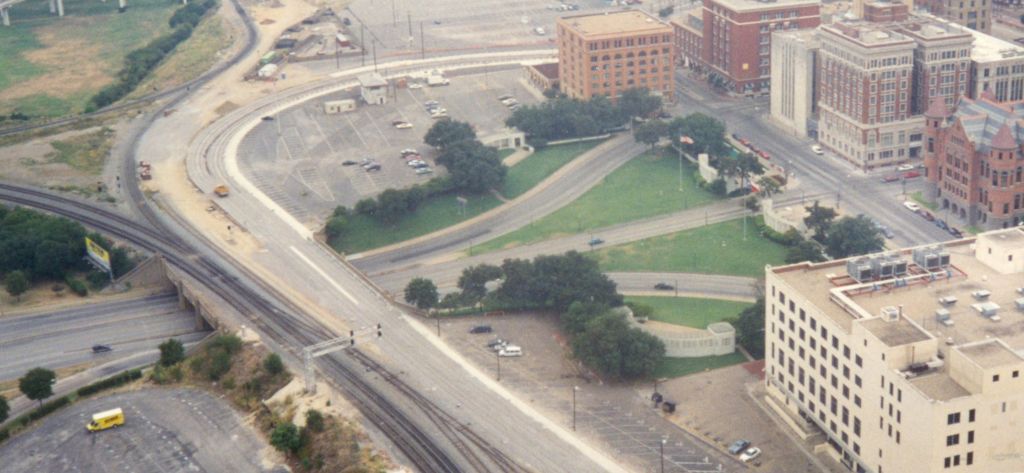
Grassy knoll. A small square with a curved arcade and a shallow pool, a national historic landmark since 1993. Strange sight: every spot looks smaller than we had expected it, projecting from the photos we have studied before. Someone has put up a banner on the lawn at the south end of which is enclosed by a wooden fence. On the other side a parking lot. The orange banner says ‚grassy knoll’. We take the couple of steps that lead to the elevation of the lawn. From the small platform we reach on top, looking back down, we can clearly make out an ‚X’ marking the spot on Elm street where the shots hit the president’s car and fatally wounded Kennedy inside. A tourist with a blue shirt and baseball cap steps quickly on the road, halts at the cross, and lifts his arms, waving to his wife who takes a picture of him. As traffic picks up again he jumps off the road, and on the pavement next to the grassy knoll he looks over to his wife. He smiles. Mission accomplished. An American coming as close as possible to history and its marks. A simple cross on the pavement, strangely cruely run over by everyday traffic, marks the end of the great age of America that started with the murder of Abraham Lincoln, ironically enough. Lincoln could become the founding father of modern USA because he paid with his life for his belief and hope of a free America. He united the States and made them become strong and idealistic. Whereas by the death of the prodigal son Kennedy, hope for a better America was killed on the way to Stemmons Freeway. The Camelot years as many American historians call the 1000 days of presidency between 1961 and 1963 were over. What is left is his absence uncannily marked by a white cross painted on the pavement. The standstill of America in the years after Kennedy somehow resonate with the puncture of the cross, right here, where America’s political belief system was pierced through. At the JFK memorial some 300 meters downtown from the cross, they have used the same strategy of remembering, piecing together what has been lost forever: surrounded by four at least 5m high walls, there is a marble pedestal of 2×2 m in the middle, with Kennedy’s name engraved in golden letters on it. Once a tourist or mourner would mount the pedestal, he becomes a sculpture that bears the name of the president: there is a little Jack in everyone of us, and there is everyone in Jack. The monument demands both a symbolic and factual stand-still by the mourner, whereas the white cross on the site of the actual crime necessitates a sort of fugitive hopping movement since this spot is dangerous due to the traffic. In the short moments of posing, the tourist seems to say: There is still life in me, I am still moving, dancing on the cross where he was shot, x-ed out. I leave my mark in my personal photo album when I come home, my mark right at the mark of history.
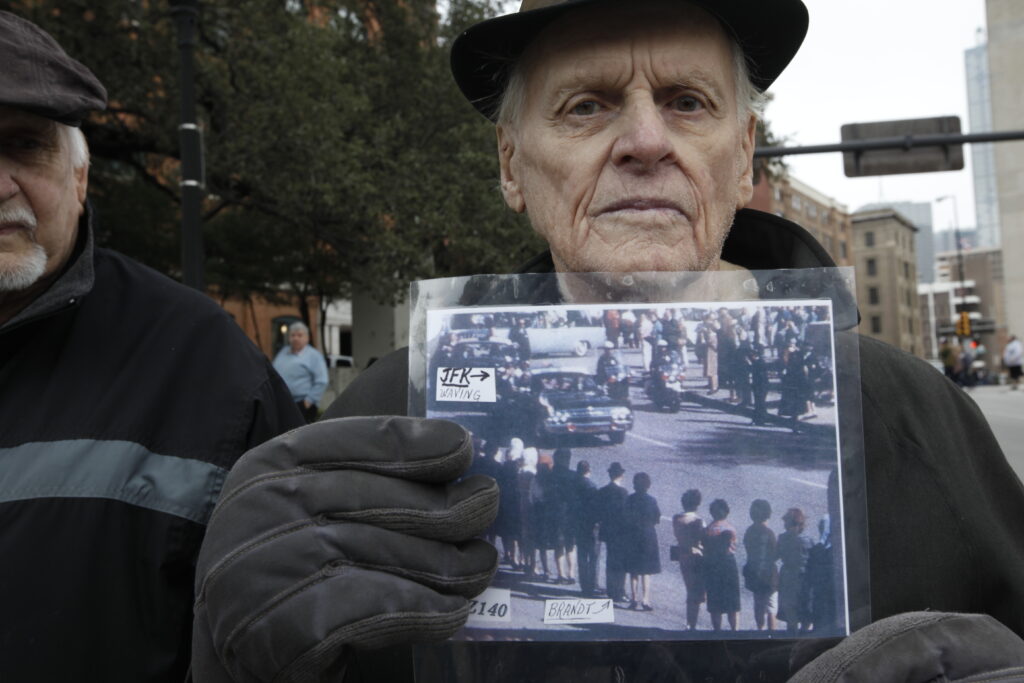
Conspiracy. Turning our attention back to the small platform where we behold a camping table with four men surrounding it. One of them stands next to a flip chart, laminated photographs in colour are pinned on it, depicting the stills of the moments before and after the shots on Kennedy. Behind him the facade of the Texas School Book Depository where the alleged killer Lee Harvey Oswald is said to have fired three shots on the motorcade on Nov 22, 1963. Alleged killer, since the man with the baton, late 50ies, dyed brown hair and glasses, doesn’t trust the official version. He grasps a microphone that is attached to a mobile p.a.. Once in a while he takes a plastic folder from the table and shows photos of the president’s open skull as it was photographed on the autopsy table in the hospital after his death. No, we are not allowed to film these photos. Due to their graphic content? No, because he is the only one who is in property of these copies and they shouldn’t be published or photographed. He holds away the file from our cameras, even though everyone who is dealing with Kennedy’s assassination is familiar with the autopsy photos. What do they prove? Not the official version of Kennedy’s assassination as they say, this one sees only one killer who shot three times from the 6th floor of the nearby Texas School Book Depository. Lee Harvey Oswald. Period. Yet the mix of historical innuendos, suspicious facts, sleazy investigation and a deep rooted mistrust into authorities lead to many different versions of this event, opposing the theory of the lone gunman. Legions of alternative theories flourished since Kennedy’s death on 22 November 1963, shelf-miles of books, movies, articles. And so the four men on the platform of Dealey Plaza present their theory: Kennedy was shot due to a conspiracy, involving some agents of the secret service one of which has fired a shot from behind the fence of the grassy knoll. The man with the glasses looks meaningfully at the old elm tree that offers his century old bark to a family of squirrels that is chasing each other up and down the tree. If this tree could speak now. So Kennedy is the victim of a „coup d’etat“, the man pauses and looks around. And since there hasn’t been found any real evidence, hard facts for this allegation this is were the other men come into play. One of them is silent as the elm tree sitting behind the camping table, presenting selected material on the circumstances of the assassination, mostly videos. This man, says the moderator with his microphone, discloses the secrets of the matter, he can provide more than just innuendo, he was counselling Oliver Stone for his infamous JFK feature in 1991. Stone’s movie stirred up the case after it was officially closed in 1988 by taking on one of the conspiracy theories, including a plot by the American secret service. And our man behind the table who still doesn’t say a word was also starring in Stone’s movie, playing a small (mute?) role as member of law enforcement. The equation: if Oliver Stone believes him, there is no reason not to trust his point of view. In order to give his argument another backup, the moderator points at two older men who somehow loiter near the table. These gentlemen are real eye witnesses who were ‘right where we are now, watching with their own eyes, listening with their own ears how the president was shot’. But neither of them says a single word. Mutes? We offer to one of them 20 Dollars and arrange an interview on the following days. We don’t have to set the exact time since the men are anyway present on the grassy knoll, selling videos and their life stories. This is what these men apparently do as a living these days, delivering their personal version of an event that has seen more pieces of interpretation than any other historical event in the 2nd half of the 20th century. They try to turn their point of view into profit, and it seems as if the whole theatre of facts here is covered by another primal American idea: the first amendment of the American constitution which grants freedom of press and the „right to peacefully assemble“. A right that apparently allows them to be at a protected historic site and turn their private memoires into a commodity. And this is why one cannot help thinking that these four men rip off tourists: taking advantage of their greed for the spectacular, they offer a bit of the president’s blood and brain on the secret photo of Kennedy’s skull, invite for some tears of nostalgia, and provide suspense by a plot that could have been written by Shakespeare.
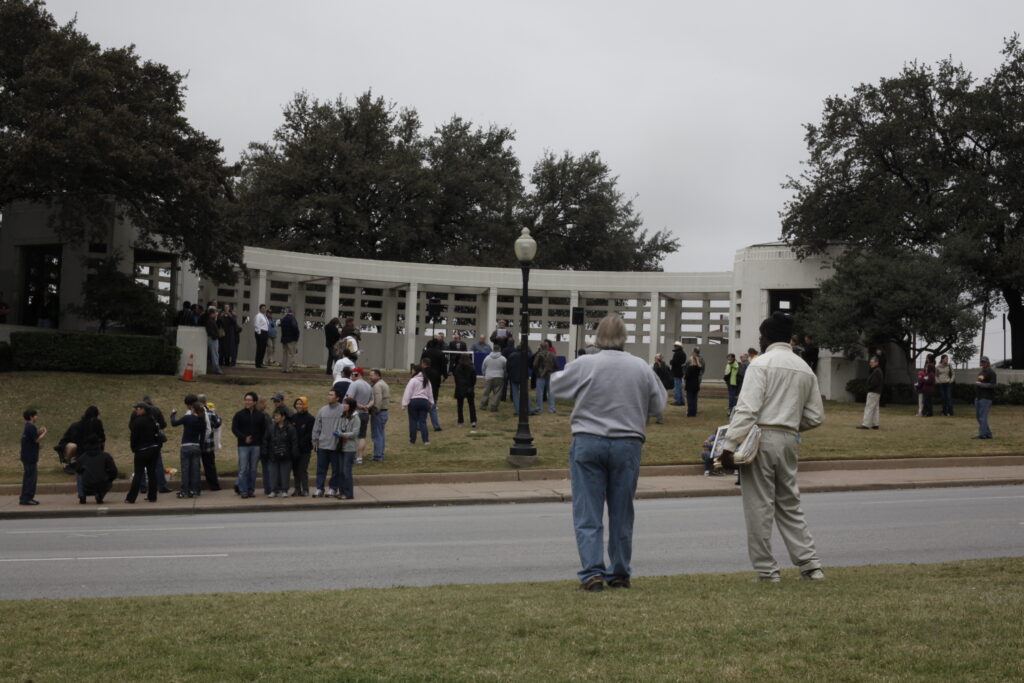
Minstrels. The whole scene looks anyhow like a theatrical act, performing a contemporary version of a 19th century ‚medicine show’. But instead of using travelling horses and a wagon like back then, the four men have settled down with a mobile table and p.a.; the trick is somehow the same: An eloquent moderator attracts the attention of the passers-by with some revealingly new insight into the secrets of life, offering remedy to those who suffer from pain. In the contemporary version remedy equals answers to painstaking questions. To prove that his drug is effective he shows patients who have been cured after using the respective drug. In the contemporary version, it’s the eye witness who can prove that the answers on painstaking questions are backed up by the truth. And then there is the third, most important party that sells the drug to the people. In our case, it’s the silent man behind the table who puts down the truth in words and videos. History becomes an act performed by histrionics who offer placebos of words and visuals, allegedly useless drugs that are supposed to enhance cultural memory but instead draw another veil over what they loudly announce as drawing back the curtain. But maybe the placebo effect kicks in in an unexpected manner. As we leave the scene, our histrionics welcome a new group of assassination tourists with exactly the same words we were approached. Our moderator knows his lines very well, he IS a professional.
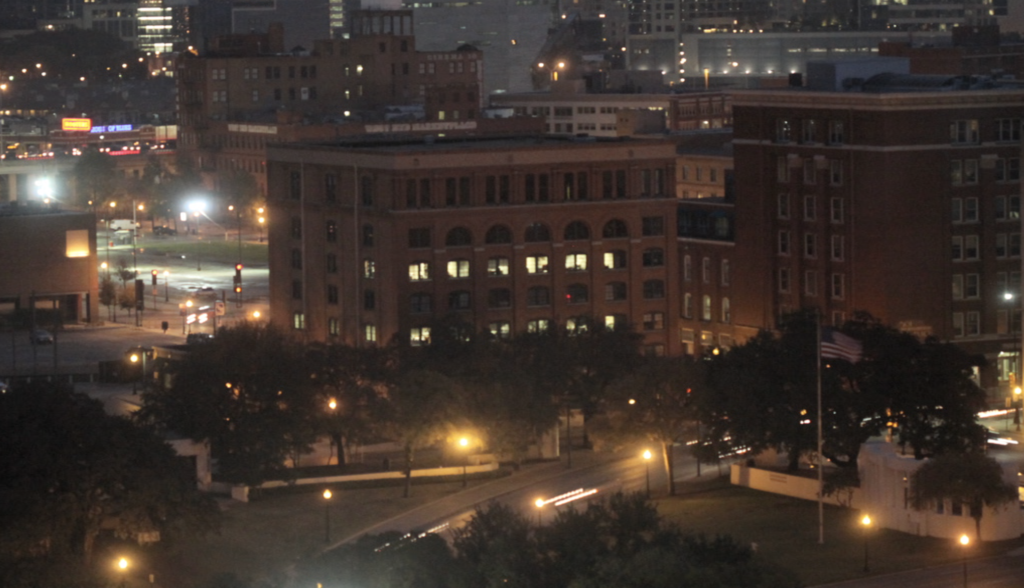
Frame 313. We move on to the Texas School Book Depository. A sign at the glass door indicates: no shooting whatsoever, neither photographs, nor guns. Makes sense in regards to The 6th Floor Museum which is, of course, on the 6th floor of the building that commemorates the shooting of Kennedy. As we enter we receive a headset for the audiotour. Students from Mexico, American tourists flood the museum aisles, following through the instructions of the voice-over coming from the headset. We pass by movable walls with texts and photos documents that pretty much cover the whole story of Kennedy travelling to Dallas: political motivation, the route, what Jackie was wearing, the circumstances of his murder, the subsequent investigations, speculations, federal commissions; a panel on Lee H. Oswald who was working in the School Book Depository at this time. They even have several models of film cameras on display that have been used by Moorman, Nix, Zapruder, bystanders who filmed the assassination from their respective spots. The privately funded museum shows a well edited version of those amateur films, reconstructing the time line of the motorcade, coming from the airport to Dealey Plaza, ending with… What? They stop the clip mix right before the famous Zapruder frame 313?
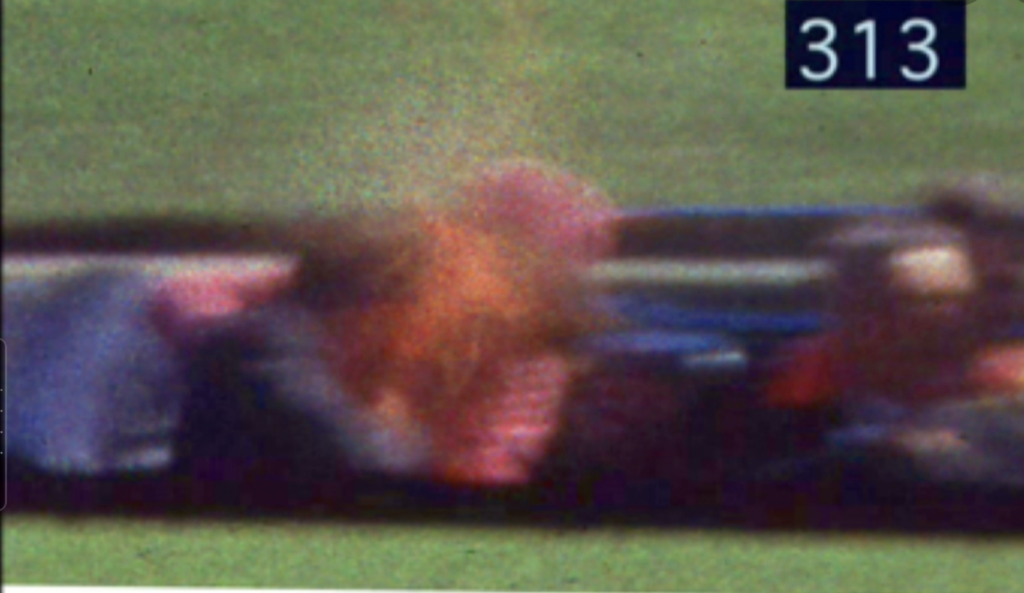
Abraham Zapruder was a business man selling ladies clothes. Living and working in Dallas, he went to Dealey Plaza on this bright day to see the President. A once in a lifetime opportunity as his assistant pointed out who convinced him to drive back to his apartment to pick up his amateur camera to film the president. Since there were too many people in the streets cheering the president he found a spot at Dealey Plaza from where he would have a good view on the president’s motorcade passing by on Elm Street. Since he was afraid of height, his assistant held him around his waist as he was standing on a ledge of the stone wall. And as the president’s motorcade turned slowly into Elm Street, Zapruder held up his camera and started filming. He didn’t know by then that he was to produce the most important and famous document of the assassination: The Zapruder film actually shows how Kennedy was fatally wounded by a bullet ripping apart Kennedy’s skull. But as a matter of fact, this part of the video is not shown in the museum. Due to respect to the president, his family, to America? Due to its graphic content? More importantly. What the film shows from frame 313 on is how Kennedy’s head seems to be pushed backwards – due to the impact of a fatal shot? Backwards by a bullet that might have hit him coming from the front. From somewhere else than the book depository where Oswald was allegedly shooting the president from behind. If the museum shows the video until the end, including the sequence after frame 313, they would have to explain why the head is tilted back. As a consequence, they would have to dispute the fact that Oswald was the lone killer who shot from the 6th floor. So how can a museum that is so diligent when it comes to fact finding not show the whole movie? Because they have to maintain a point of view that favours the idea of Oswald being the main suspect in order to legitimate their own existence?
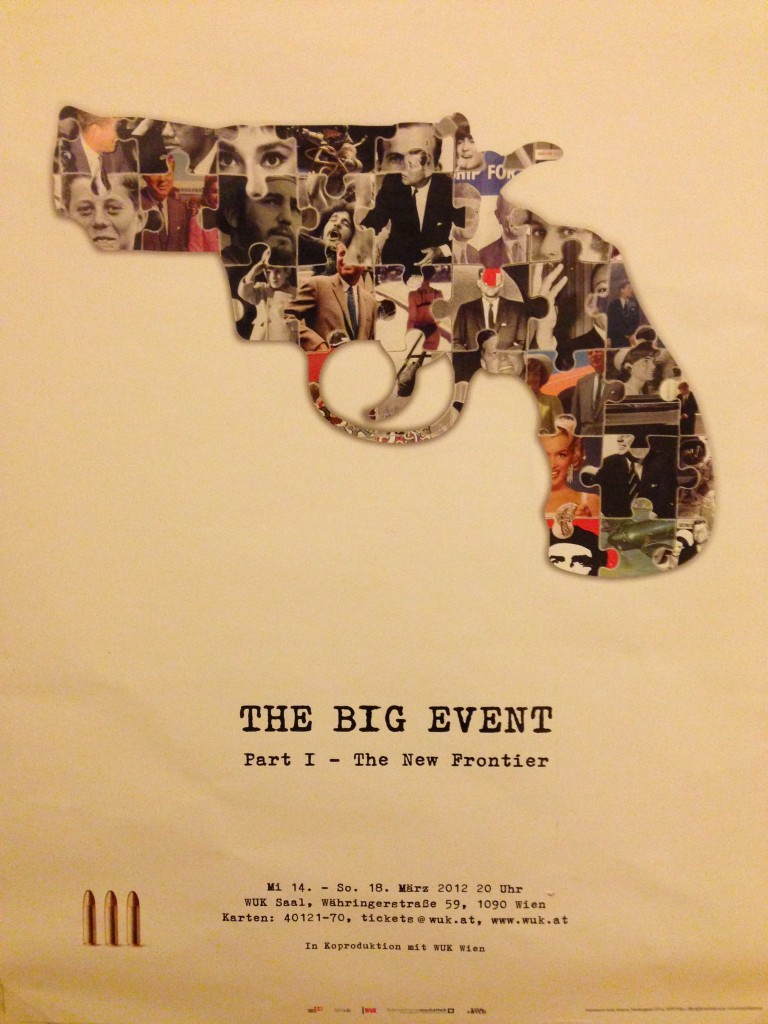
History tanks. It’s not permitted to take pictures on the floor. Due to copyright infringement since the objects and photographs belong to companies or legal persons, says Liza from the museum. She says this with a smile as if this was self-understood. No photos neither from the objects nor from the 6th floor itself. Or from the spot from where Oswald is said to have shot at the president. The museum has constructed a glass cage to seal this area off from the public. Inside the glass tank they have put card board boxes the way the police said to have found them after they have arrested Oswald. Oswald allegedly hid behind a stack of boxes and placed four of them next to the window so that he could put his rifle onto them in order to aim better. This is what this arrangement’s logic suggests at least. Since everything about the assassination is about traces that are undiscoverable, here at least, on the 6th floor, the assassin has left something posterity can behold. It’s with his own hands the assassin created his hideout and sniper’s nest as if Oswald had left the crime scene a few seconds ago.
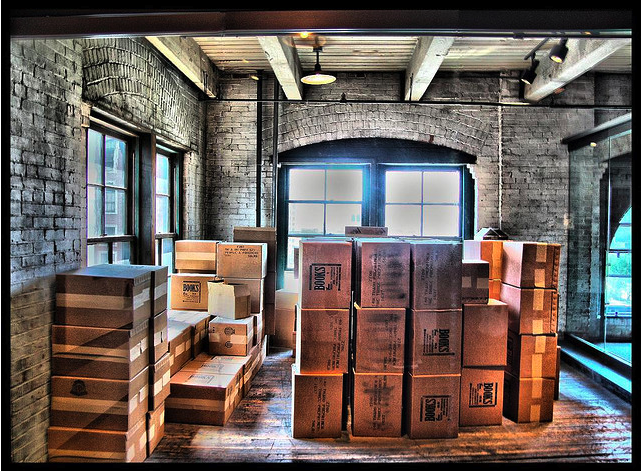
The cage with the boxes proposes an act of authenticity that is not only dubious, but shows a twisted understanding of what a fact is. The cage pretends transparency of history by the means of scenography. It wants to authenticate where there is a lack of authenticity. It wants to give immediate insight in the scene where there is no other coverage documenting what really has happened. The cage wants to overwhelm the beholder by sealing the scene off for the public as if the beholder would look at a precious relic: this is how it WAS instead this is how it COULD HAVE BEEN. A wrong understanding of immediacy comes into play. An immediacy that proposes facts which are none, that proposes history which is only a reenactment, that proposes accuracy of events which only can be speculated upon. History doesn’t speak here, it’s the marketing department of the museum that talks – loudly.
The assignment of a museum is to preserve, store, and take care of artifacts. Giving access to the telling document in the context of its time and preserving its accessibility. In such a sense, the documents, photos, videos or sound files presented to the public become accounts of what has happened, they are media from their respective points of view, they mediate, transport history, but don’t translate it. Even though most of the documents on display are not originals, being copies, they nevertheless keep their basic function of exemplification. In such a way they are time witnesses for they both witness a certain sequence of time and temporalize the witness, give him a context that is always relational to the standards of a given perception of the time he comes from. The post mortem arrangement of the card board boxes in the aquarium is not doing that. The aquarium tanks the events as the arrangement is ahistorical; as it attempts to freeze the situation of the murder, to bring the moment to a standstill by turning the situation into a moment of eternity, as it attempts to recreate the origo of the moment itself to be taken for the original, as it places the beholder both inside and outside the scene without granting him to see what the sniper might have seen, the arrangement of boxes fabricates an event that turns the beholder into an eye witness of second degree. The second degree witness hasn’t seen anything real really, it’s rather hearsay, rumours, visual Chinese whispers he is presented, and yet he thinks he has witnessed the ‚real thing’ since the scenography suggests realistic immediacy. Staging history theatricalizes facts in such a way that the spectator can’t develop a point of view about what was happening. He is turned rather into a consumer of history. He shall eat it, chew and swallow it the way it was cooked right before his eyes.
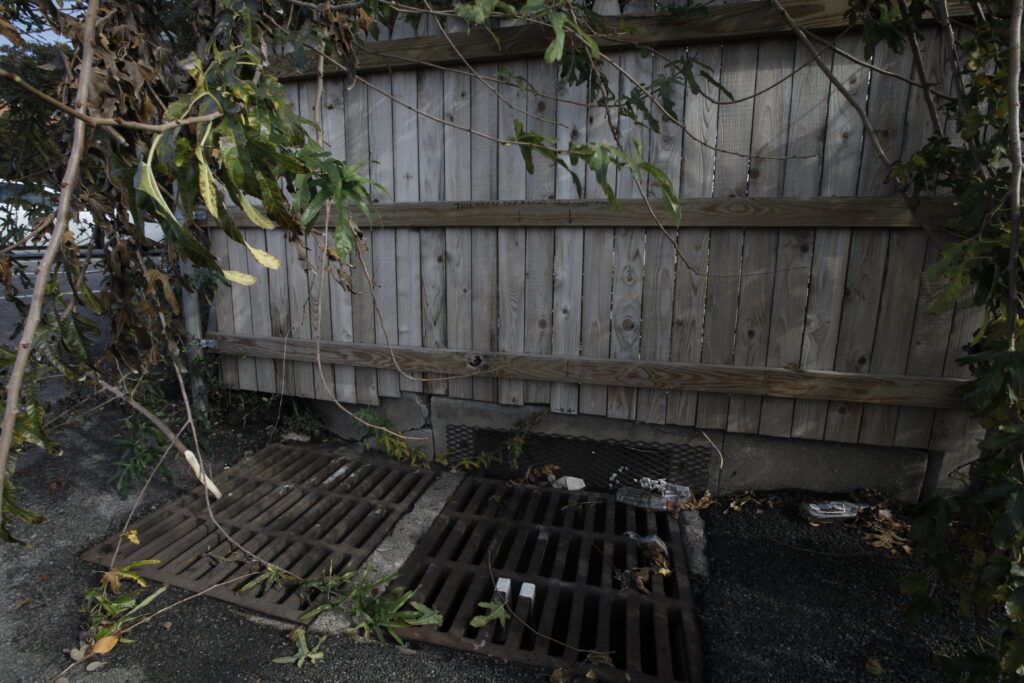
People we have met who had developed particular theories on the assassination (selection): Father and two sons from Vermont (national guard and ex-military secret agency), an author specialized on conspiracies, a retired NASA engineer, a physicist (male) and politologist (female), a tour guide and ex-law enforcement member, a retired police man, an eye witness, a weird stranger
Their theories:
The president was killed by Oswald
The president was not killed by Oswald since the rifle he was using was of minor value
The president was killed by two shots from the 2nd floor of the TSBD
The president was killed by 13 shots from all over Dealey Plaza (crossfire from all over)
The president was killed by an agent who hid behind the fence from the grassy knoll
The president was accidentally killed by machine gun fire of an agent who was in the motorcade
The president was killed by an agent who hid in a manhole near the triple underpass
The president was killed by a conspiracy involving the Secret Service (FBI, CIA)
The president was killed by a conspiracy involving the mafia
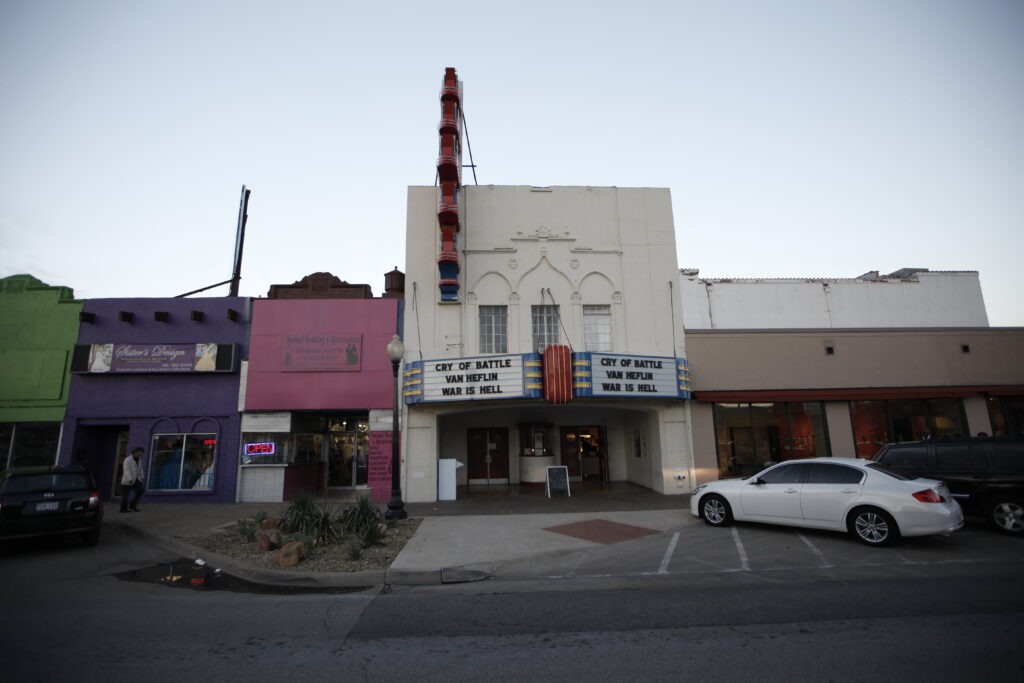
Cry of Battle. We are in the foyer of the recently reopened Texas Theatre. This is the cinema where Oswald was arrested by the police in 1963. After killing police officer J.D. Tippit and the President of the United States, he is said to have entered the show room of the cinema, take a seat, and watch the feature Cry of Battle. On 22 November 2011, the theatre presents the movies that were screened on the same day in 1963. With us in the lobby two Dallas-based film makers, Steve and Marc whom we have met at Dealey Plaza earlier today. They have been so kind and generous to show us around, give us a tour through some districts of Dallas we haven’t been visiting so far. Both of them were participating as photo experts in a Discovery Channel reconstruction of Kennedy’s assassination a couple of years ago. They say: recalling our photo analysis, Oswald couldn’t have conducted the assassination of JFK, period. Since Steve knows one of the new owners of the Texas Theatre he wants to help us to convince him of letting us shoot inside the movie theatre without having to pay a location fee of 400 $. Which would be a bit too much for our taste and wallet, as we don’t want to be ripped off. We settle an agreement that we can take photographs – for free.
We only have to pay a symbolic contribution of 1 $ for Cry Of Battle which back then, in 1963, cost 75 cents, and take a seat in the last row. The auditorium holds places for appr. 300 visitors, yet today only some 20 spectators show up. When Oswald enters the auditorium on 22 Nov 1963, the film is already playing for about an hour. He takes a seat three rows from the back, four seats from the left. Why would he enter the theatre? To win time until the first agitation blows over? Does he have a secret meeting with a helper, maybe a CIA agent? The owners of the cinema have marked Oswald’s seat, attached a sign on the back rest.
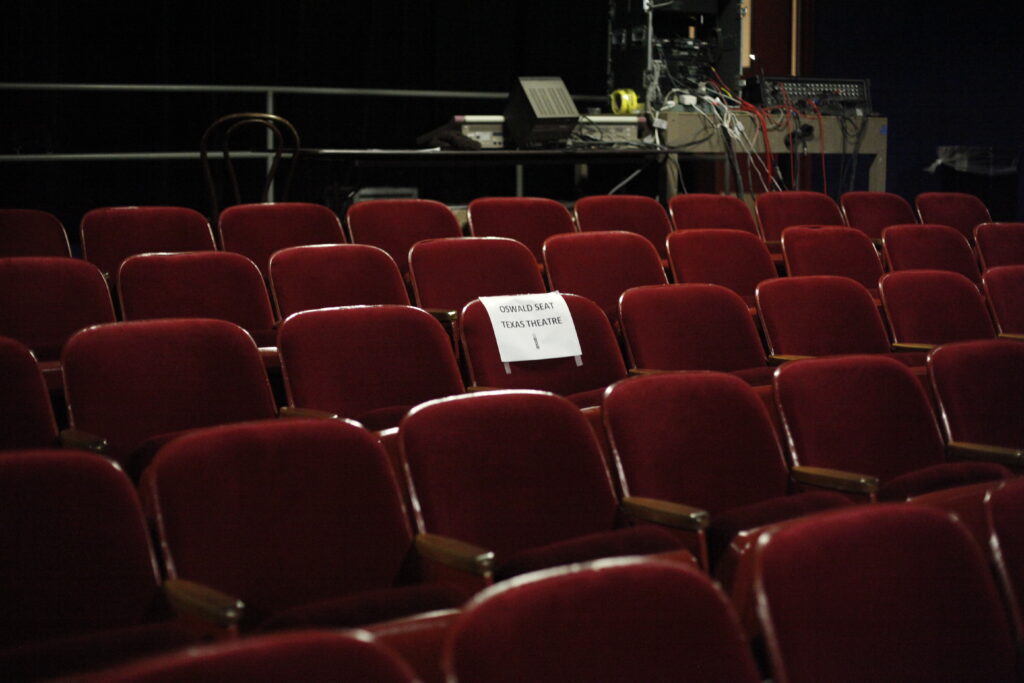
The guy who permits us to take a picture, a young, excited man in a business suit welcomes some of the Oswald buffs. We have seen quite some of them during the conference and the memorial service at Dealey Plaza we have attended in the morning. One of them takes a seat right next to the empty Oswald seat, embraces the chair as if Oswald were sitting in it, and has a friend taking a picture of himself. Yet nobody dares to sit on Oswald’s chair though, nobody wants to take on his point of view. In an astonishing opposition to the behaviour visitors exhibit on the X on Elm Street that represents the spot John F. Kennedy was fatally hit by gun shots. At Dealey Plaza, a lot of people enjoy placing themselves right on the spot.
Nobody wants to look with Oswald’s eyes, but rather wants to identify himself with the object of what Oswald beholds. Nobody wants to be at the spot from which the gaze is projected, but rather desires to be in the focus of the beheld object. If one indulges in a feminist film theoretical thought in this case, the assassin Oswald fulfills the role of the male spectator who remains invisible, who aims at the feminine object (Kennedy) from the dark. The observer is obscene = off stage, a Peeping Tom who watches in a stealth mode through his rifle scope. Whereas the object of desire is depicted in full light, selling out to the punters, rendered desireable for this fact. The object that is created through this scope is both visible for the privileged, obscene eye of the male (assassin) and overall visible (the other meaning of obscene) for everyone. Kennedy, the feminized victim (if one wants to follow this thought to the end), sits in an open car, presents himself in the most palpable scene possible. The car, the machine moves him, a kinky extension of his body, an application that grants exposure of power and the power of exposure. An overexposed body with an obscenely open orifice as he cheers to the crowds, waving, welcoming the public to stare at him. From our last row seats, we stare at the movie and watch from Oswald’s angle over Oswald’s absent shoulder. ‚We take a shot at the film’, I think to myself. To take a shot like Oswald did; American English has an uncanny proximity to military rhetorics. The characters in the movie take a lot of shots. It is about a spoiled son of a wealthy businessman during world war II who finds himself involved in the guerrilla movement fighting against the Japanese, and finds romance and adventure. Romance equals the conquest of submissive women; adventure means shooting Japanese, both taught to him by a macho maverick. Don Delillo writes in his book Libra that these female characters were invented to please the lonesome male afternoon cinema goer. They were designed to show off their legs, physical attraction and provide pleasure for the viewers. Those characters, oversized and in full light projected on the cinema screen are in the crossline of the viewers’ attention.
Is Oswald capable to watch what’s going on in the movie, right in front of him? Is he attracted to the women on the screen after all, as are the soldiers in the movie? Does he identify with the young hero who eventually wins the girl over? What do the sniper’s eyes see, which are the eyes of the ultimate male, looking, acting in the dark, deciding in the dark, turning the world into a cinema auditorium packed with present or absent snipers aiming at the object of their desires? The fact that nobody wants to sit in Oswald’s chair is maybe driven by the same impulses that prevent the visitor of Texas School Book Depository to go to the spot from where Oswald is said to have fired his shots: because the nature of that scene is not just cruel, or graphic, it’s rather pornographic. For isn’t it true that the president’s body is penetrated by at least three bullets which enter his body, leave entrance and exit holes? Rendering the presidential body into both a horrific and an ‚orific’ object where the horror of the shooting is doubled by turning Kennedy into a feminized body with several gaping openings? And all those who stand on the X, having their bodies taped by video cameras, don’t they turn their videos into X-movies by demarcating the disrobing uncovering of the President?
